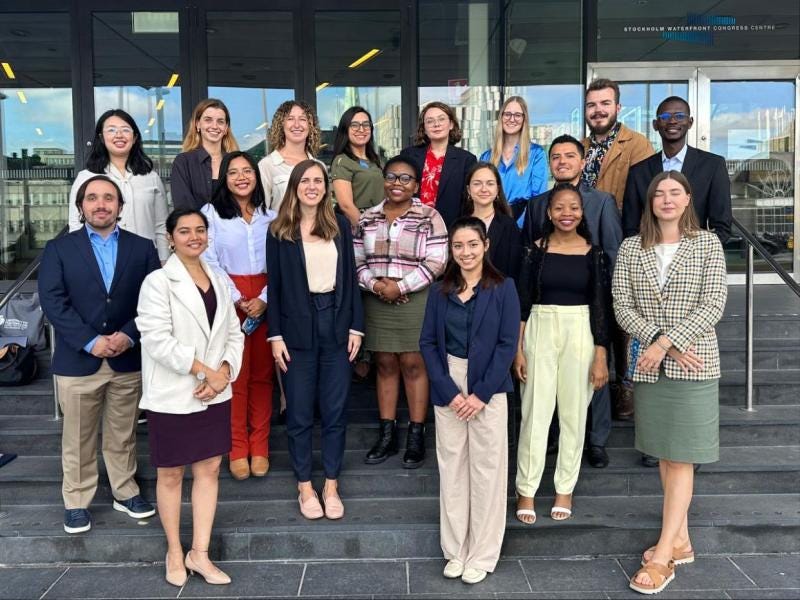#28: How I Spiraled Into Eco-Anxiety – And How I Cured It Through Action
A Gen Z Hong Kong native reflects on her emotional rollercoaster of declining the corporate path and instead diving into climate and water risk research.
Wishing You Prosperity in the Year of the Snake! As we step into the Lunar New Year, we invited Sophie Lam to share her inspiring journey of overcoming eco-anxiety. Sophie, who is in her early 20s, is a climate and water analyst at CWR, a Hong Kong-based think tank.
In this essay, she reflects on the emotional rollercoaster of the past three years – starting with confusion, denial, and fear when first confronting the stark realities of climate disasters, followed by overwhelming anxiety and uncertainty, and eventually, a deep sense of urgency to wake up those sleepwalking into a boiling planet. She also speaks to the loneliness, helplessness, and frustration of struggling to find connection, empathy, and understanding – before finally discovering hope and optimism by celebrating small victories of herself, her colleagues, and her peers.
Sophie’s story deeply resonates with my own journey. A decade ago, I left journalism and joined CWR, after realizing that merely having a front-row seat to history did not fulfill my desire to drive social change. At CWR, I worked on research, investigations, and extensive stakeholder engagement to push businesses and financial institutions toward proactively tackling China’s environmental challenges, rather than standing by or taking advantage of the crisis. There, I learned to transform my cynicism, political frustration, and climate anxiety into strategic vision and agile action.
It was also during my time with CWR that I realized I should not limit myself to just writing to inform but that I should write for change. In many ways, writing and editing the Shuang Tan newsletter has become my own way of coping with climate anxiety, channeling disappointment and frustration into inspiration and collective consensus as I continue the long and urgent fight to save the planet.
I started this newsletter with one simple belief: Iit’s impossible to effectively tackle climate change without China, just as it’s impossible to build a prosperous China without adequate climate action. But as geopolitical turbulence continues, climate “islands” and “oases” are quickly turning into deserts. Do we really just need more diplomatic statements, policy analyses, and technological breakthroughs, or is something deeper holding us back? Perhaps more personal stories like Sophie’s could remind us why we are fighting this fight – for the planet, for humanity, and for people we love and care about.
I hope you enjoy this newsletter. Upgrade your subscription to read more powerful personal essays from Chinese journalists, social entrepreneurs, and campaigners as they reflect on their struggles, insights, and actions from the ground.
On a related note: I start to take clients as an authenticity and resilience coach. In this role, I hope to support more climate advocates and civil society professionals as they navigate personal and professional challenges – including learning to live with climate anxiety. For inquiries, please contact coach@liuhongqiao.com.
Essay: How I Spiraled Into Eco-Anxiety – And How I Cured It Through Action
A Gen Z Hong Kong native reflects on her emotional rollercoaster of declining the corporate path and instead diving into climate and water risk research.
By Sophie Lam
Edited by Hongqiao Liu and Kevin Schoenmakers
Three years ago, I was a fresh graduate from a U.K. university. Like most of my peers, I was set on a future in finance or consulting. Then I heard Debra Tan, the director of CWR, speaking at an event. The next thing I know, I threw my carefully plotted career plans out the window.
“Carbon is how we cause climate change; water is how we mostly feel it,” I remember Debra saying. Her talk shattered my narrow “carbon tunnel vision” and drowned me in the stark realities of water adaptation challenges that go far beyond reducing carbon emissions.
Growing up in Hong Kong, I had never considered that my home city, a wealthy global financial hub, would ever have to worry about water scarcity. After all, Mainland China has always ensured a stable fresh water supply for Hong Kong – what could possibly go wrong?
Carbon is how we cause climate change; water is how we mostly feel it.
But then I discovered that this water is brought into the city by low-lying pumping stations, and that the city’s water supply is at risk of collapse because this critical lifeline is vulnerable to both powerful typhoons and rising seas.
That revelation felt like opening Pandora’s box. My naive self was thrown into an overwhelming whirlpool of information about the cascading impacts of climate change.
Terrified yet intrigued, I decided to dive deeper. I soon began a three-month internship at CWR, a Hong Kong-based think tank dedicated to embedding climate and water risks into business and finance.
Support Shuang Tan
Shuang Tan is an independent initiative dedicated to tracking China’s energy transition and decarbonization. The newsletter is curated, written, and edited by Hongqiao Liu, with additional editing by Kevin Schoenmakers.
It was during this internship, while I assisted with mapping the city’s critical infrastructure such as rail lines, power supply equipment, and cold storage facilities against rising sea levels, that I came to another harrowing realization: within my lifetime, rising seas could permanently submerge thousands of Hong Kong homes – including my own.
Three months flew by. Determined to explore adaptation strategies that could save my home from being swallowed by the sea, I turned down a corporate job offer in the U.K. and joined CWR full-time.
I absorbed knowledge about climate and water risks like a sponge. My typical morning went like this: I logged monthly climate disasters and pored over scientific papers on vanishing glaciers, unstable tipping points, and record-breaking heat waves.
I am glad that I can use my knowledge of GIS software – which combines data with maps – to examine the impact of rising sea levels and extreme weather events on critical infrastructure in the Asia Pacific region. I also had the opportunity to work on CWR’s Re-IMAGINE HK initiative, which advocates for transformative adaptation by the Hong Kong government to save the city from future coastal threats. These efforts are all focused on improving resilience planning and managing the risks posed by climate change.
The more I learned about the interconnectivity of climate and water risks, the harder it became to stay optimistic about our future.
Nonetheless, I often felt myself coming back to the same questions. Given the worsening climate situation, is the work I’m doing meaningful? And how on earth am I making any impact?
The more I learned about the interconnectivity of climate and water risks, the harder it became to stay optimistic about our future. The data painted a grim reality: Our current emissions trajectory points to over 3°C of warming, and for Hong Kong, rising seas could jeopardize food supplies, flood transport systems, and cripple power infrastructure.
The weight of this knowledge, combined with my growing eco-anxiety, left me feeling out of sync with those around me. Desperate to spark conversations, I began sharing my “sea level rise 101” lectures and underwater HK maps with friends and family. But their typical reactions – disbelief, denial, or helplessness – only deepened my frustration. Even seasoned professionals at climate-related conferences offered little more than vague concern.
Loneliness and a sense of futility crept in, and I found myself spiraling into an eco-anxiety doom loop.
It seemed like no one else actually understood the severity of the crisis besides my colleagues at CWR. Loneliness and a sense of futility crept in, and I found myself spiraling into an eco-anxiety doom loop.
Despite everything, I continue to do what I do because, deep down, I know I am not alone in this fight. More importantly, as the youngest member of my team, I want to show the world that our generation has not given up – we still have opportunities to avoid the worst-case scenario.
Over the past three years, there have been moments that gave me hope. For example, CWR was invited to HSBC’s headquarters to present to concerned business leaders in the real estate, insurance, and utilities sectors on the topic of sea level rise risks in Hong Kong. Moments like these reassured me that the work my organization does is reaching the right people and making an impact.
I want to show the world that our generation has not given up – we still have opportunities to avoid the worst-case scenario.
I am also fortunate to have encountered many inspiring young people through my work. At the 2023 Stockholm International Water Week, I met Meghna Chakraborty, a junior rapporteur who founded the South Asia Young Women in Water platform shortly after the conference. This initiative empowers young women to lead conversations on water management. I also met numerous young inventors tackling issues such as pollution from microplastics or crude oil spills with innovative solutions.
As an individual, we cannot control the accelerating pace of climate change, but we can still focus on the small yet meaningful changes.
To this day, I have no regrets about straying away from the corporate path. Joining CWR has opened my eyes to both the challenges and potential solutions for addressing water risks.
In my three years of working on climate and water issues, I have learned how to initiate uncomfortable but necessary conversations that drive meaningful change. While I constantly remind myself that climate change is not something we can solve overnight, I know that we no longer have the luxury of time.
It might be true that as an individual, we cannot control the accelerating pace of climate change, but we can still focus on the small yet meaningful changes we can make to combat it. We may have more collective bargaining power than we realize to influence corporate behavior. So, don’t be afraid to speak up and share your ideas.
After all, it’s our future that’s on the line. We must act now!
* The article is adapted from Sophie Lam’s essay that first appeared in CWR’s monthly newsletter.
* Cover Image Credit: Valeria Araya for ArtistsForClimate.org
Get in touch
I hope you enjoy this newsletter. Share your thoughts in the comments.
If you’d like to write for Shuang Tan, republish our articles, or submit a testimonial, email us at contact@shuangtan.me.
Until next week,
Hongqiao








